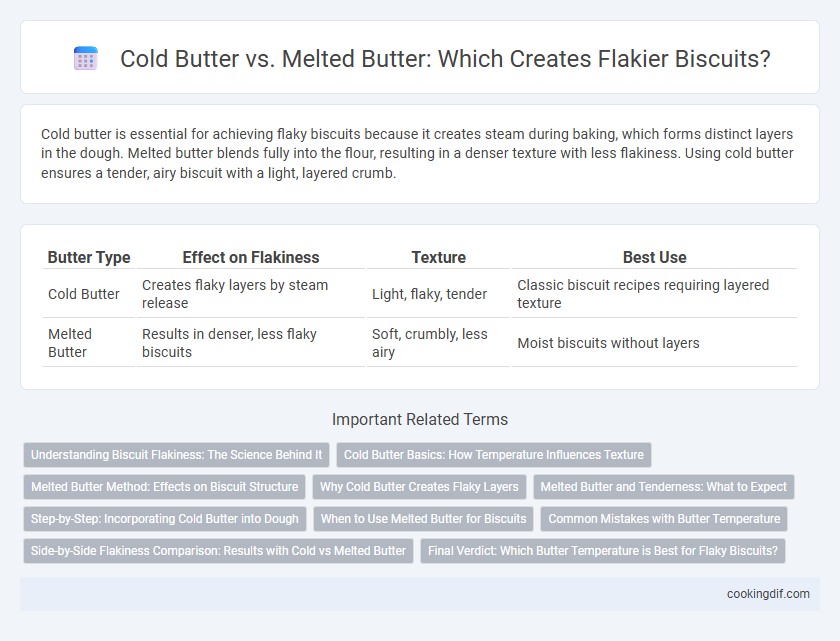Cold butter is essential for achieving flaky biscuits because it creates steam during baking, which forms distinct layers in the dough. Melted butter blends fully into the flour, resulting in a denser texture with less flakiness. Using cold butter ensures a tender, airy biscuit with a light, layered crumb.
Table of Comparison
| Butter Type | Effect on Flakiness | Texture | Best Use |
|---|---|---|---|
| Cold Butter | Creates flaky layers by steam release | Light, flaky, tender | Classic biscuit recipes requiring layered texture |
| Melted Butter | Results in denser, less flaky biscuits | Soft, crumbly, less airy | Moist biscuits without layers |
Understanding Biscuit Flakiness: The Science Behind It
Cold butter creates steam pockets during baking as it melts, which are essential for flaky biscuit layers by separating the dough. Melted butter lacks this structure because it blends fully into the dough, resulting in denser, less flaky biscuits. Understanding the physical state of butter and its interaction with dough temperature is crucial for achieving ideal biscuit flakiness.
Cold Butter Basics: How Temperature Influences Texture
Cold butter creates steam pockets as it melts during baking, resulting in flaky biscuit layers. Using melted butter blends fully into the dough, producing a denser, less layered texture. Maintaining butter at a cold temperature before mixing ensures optimal flakiness by preventing premature incorporation into the flour.
Melted Butter Method: Effects on Biscuit Structure
Melted butter integrates fully into biscuit dough, resulting in a uniformly soft texture but reduced flakiness due to the absence of distinct butter layers. Unlike cold butter, melted butter prevents steam pockets from forming during baking, which limits the rise and lift essential for flaky layers. This method produces biscuits with a tender crumb but lacks the characteristic buttery, layered structure favored in flaky biscuits.
Why Cold Butter Creates Flaky Layers
Cold butter in biscuit dough remains solid during mixing, creating distinct layers as it melts and evaporates in the oven, which produces flaky textures. The steam released from the cold butter causes the dough to puff up, forming pockets that separate the layers. Melted butter lacks this effect, resulting in denser, less flaky biscuits.
Melted Butter and Tenderness: What to Expect
Melted butter in biscuit dough results in a tender crumb due to its even incorporation, which reduces distinct layers and limits flakiness. The fully blended fat creates a softer texture that melts throughout the dough, producing moist and delicate biscuits. Bakers seeking a tender, cake-like biscuit often prefer melted butter for its consistent softness.
Step-by-Step: Incorporating Cold Butter into Dough
In biscuit dough, incorporating cold butter creates distinct layers that lead to superior flakiness compared to melted butter, which blends fully into the flour. To achieve optimal texture, cutting cold butter into small cubes and gently folding it into the flour until pea-sized pieces remain preserves pockets of fat that steam during baking. This step-by-step method ensures flaky biscuits by maintaining temperature contrast crucial for layering, resulting in tender, airy, and crispy layers.
When to Use Melted Butter for Biscuits
Melted butter in biscuit recipes creates a denser, more tender texture rather than flaky layers, making it ideal for biscuits intended to be soft and cake-like. Use melted butter when you want a richer flavor that fully integrates with the dough, such as in drop biscuits or when baking with whole wheat flour. This method suits biscuits that benefit from moisture retention and a buttery taste instead of traditional layered flakiness achieved by cold butter.
Common Mistakes with Butter Temperature
Using chilled butter rather than melted butter is essential for achieving flaky biscuits, as cold butter creates steam pockets during baking that lead to layers. A common mistake is allowing butter to soften too much, which causes it to blend too fully into the dough, resulting in dense, less flaky biscuits. Ensuring the butter is cold and cut into small pieces before mixing preserves its structure and maximizes flakiness.
Side-by-Side Flakiness Comparison: Results with Cold vs Melted Butter
Cold butter creates pockets of steam during baking, resulting in distinct flaky layers and a tender crumb in biscuits. Melted butter blends fully into the dough, producing a denser, less flaky texture with softer consistency. Side-by-side flakiness comparison reveals biscuits made with cold butter exhibit superior rise and layered crispness compared to those using melted butter.
Final Verdict: Which Butter Temperature is Best for Flaky Biscuits?
Cold butter is essential for achieving flaky biscuits because it creates steam pockets during baking, resulting in distinct layers and a tender texture. Melted butter, while convenient, tends to produce denser biscuits as it fully incorporates into the dough, reducing flakiness. For optimal flaky biscuits, using cold butter cut into small pieces ensures the best layering and a light, airy crumb.
Cold butter vs melted butter for flakiness Infographic

 cookingdif.com
cookingdif.com